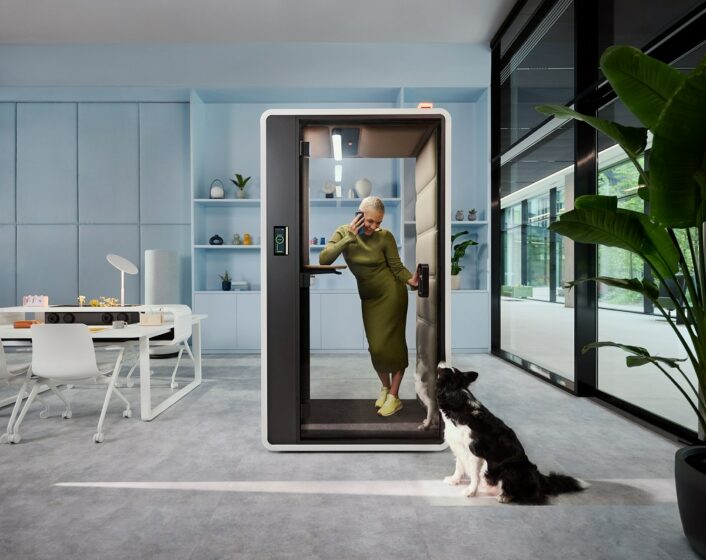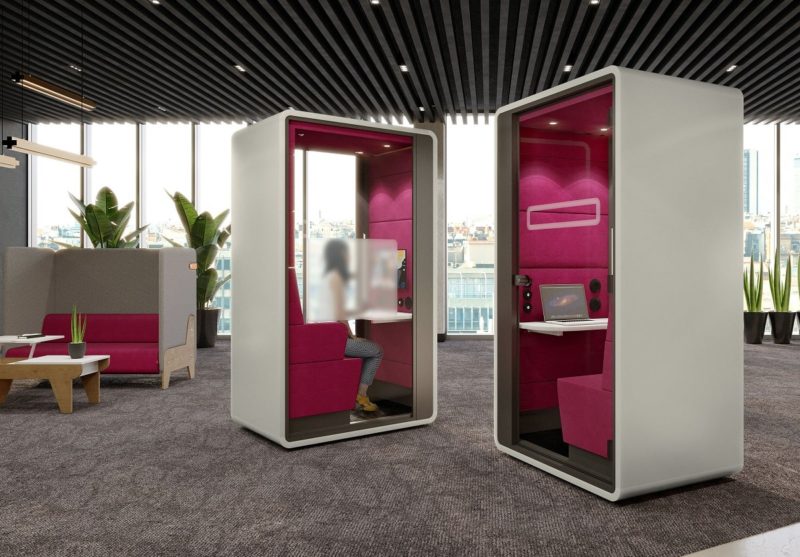The paramount trends in office design for 2024
- Posted on: 30 January 2024
- By: Hushoffice Team
There might not be a better moment than the start of a new year to reconsider the design of the place where individuals dedicate over 20% of their lives intently: the office. Below are some of the key trends in workplace design for 2024.
Office design trends for 2024 – tl;dr
As employee’s need for privacy is becoming more and more pronounced, office pods will become the norm.
The office arrangement will be designed using a more multisensory approach by planners. This method will best support neurological diversity by providing a range of sensory scapes.
Wide task-environment-fit will be pivotal in an ever-more diversified workforce. The way forward resides in adaptable interior concepts. Therefore, adjustable furniture and sit-stand desks will become standard.
86% of workers would rather work for organisations that are concerned about the challenges they face. Therefore, it will be crucial that new office products “do good” this year. i.e., steward earth and advance societal goals. Businesses will seize the chance to uphold these ESG commitments by dint of the office.
There will be a greater importance to the conversation spaces. For the enormous 94% of workers who feel it’s critical that their place of employment is somewhere they identify with, they will foster a sense of community.
Activity-oriented designs, which prioritise acoustic seclusion, are expected to gain prominence.
This year, private places will no longer be negotiable. Nearly 80% of workers claim that their productivity is dependent upon them.
The best will still be drawn to (and satiated) by flexibility, which will keep on reigning supreme.
In order to perform at their best, 96% of US workers claim they require flexibility. Flexibility in terms of working hours, location freedom and work autonomy. The truth is that flexibility can be of value at every stage, beginning with the desk — there is a significant increase in job satisfaction among employees who are in charge of their own setup.
One of the top three incentives for job seekers is a flexible work schedule
Approximately two thirds of US employees see workplace flexibility options (such as hours and location) as more significant than paid leave, competitive bonuses, pension plans, and healthcare benefits
Nearly 87% of American workers would want to work remotely if given the opportunity.
According to studies, modern employees expect flexibility throughout their whole employment path. Manufacturers of office supplies and space designers like the team of Hushoffice, who have long placed a premium on flexibility, are thrilled about this. We have been pioneers in advancing the notion that accessibility and flexibility go in tandem for a long time. Flexible environments and products are, at the end of the day, by their very nature employee-oriented, as they can be adjusted by users. Workplace designs and organisational structures will therefore become more inclusive of all groups of people as they adapt to the needs of the workforce
– states Mateusz Barczyk, Senior Brand Manager, Hushoffice.
In order to provide “task-environment-fit” for a diversified workforce, the workplace must be adaptable.
The idea explains how an employee’s workplace and requirements should complement one another. Of course, employees work better and are more satisfied with their setup when there is a good “fit”. A “fit” has even been demonstrated to increase grit in workers, enabling concentration and commitment to long-term objectives in spite of calamity.
By providing more spaces in the office, a lot of people will give their workers an extra degree of flexibility.
By dint of access to a multitude of subspaces, workers can go to the right space for each moment’s necessity (and their developing personal needs). It should come as no surprise that the biggest influence on results in an activity-based workplace is the availability of appropriate environments.

Flexible lighting options and furniture will distinguish successful office goods.
Employees desire a diverse array of environments and experiences in the office. Variety, to put it simply. User-controllable technologies that accommodate a variety of workstyles serve as the foundation of such a workspace. Retractable window blinds. Adjustable fans. Leaning stools at sit-stand workstations allowing for natural perch postures. And so forth.
In 2024, it becomes an issue of sense to design for the sake of accessibility.
To put it more accurately: it becomes an issue of all five senses. Designing the office by means of neurodiverse ideas refers to looking at the workplace from a sensory point of view. This multisensory strategy will inevitably become more common in order to systematically accommodate the numerous personal preferences of an ever-more diversified workforce.
The goal of universal layout remains continuously chased. It may be quite daunting and convoluted. A lot of planners categorise people based on their age, cognitive capacity, and various other demographics. Nonetheless, it can be beneficial to recognise that, in the end, all humans are sensory beings who are impacted by sounds, sights, and scents. Consequently, a wide range of sensory scapes in the workplace — from bright to dim, lively to quiet, strong in colour to subdued — are required to meet the diverse and constantly evolving demands of employees. This kind of sensory-aware design will undoubtedly become increasingly popular as a means of optimising workplace accessibility and making it as functional as possible for all users
– adds Mateusz Barczyk, Senior Brand Manager, Hushoffice.
Find out more: Office design for a neurodiverse workforce
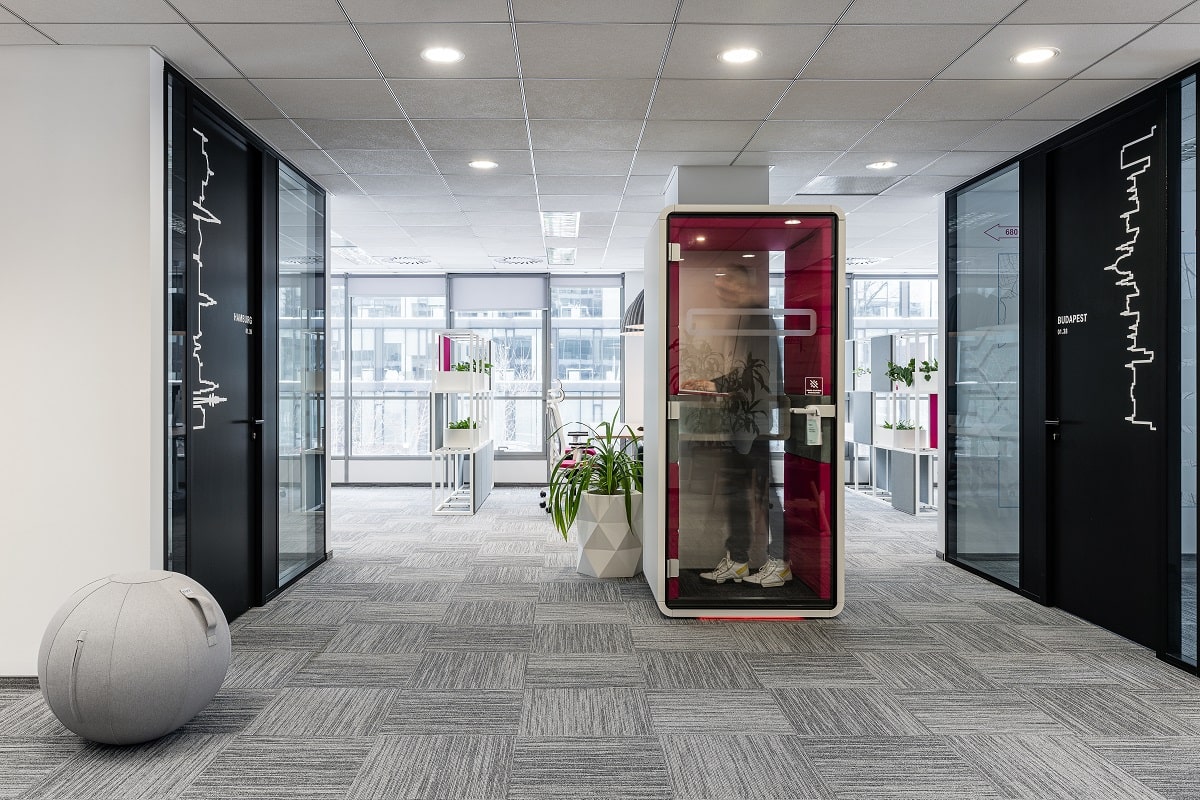
All new products launched in 2024 will need to show ESG dedication and steward earth.
According to 83% of clients, businesses ought to actively contribute to ESG practices. 86% of workers would rather work for organisations that are concerned about the challenges they face. Maybe this explains why 91% of business leaders believe their organisation must take action on ESG matters.
The office will be able to clearly demonstrate the company’s commitment to advancement.
It is considered one of the few places in a digital world where commitments to advancing global good can actually come to pass. Designers can and ought to utilise this potential by making sure that each new flooring solution, piece of furniture, or lighting fitting moving forward meets the appropriate social and environmental standards.
Regarding office interiors, accessibility and equity can take many different shapes.
Every new interior design solution should always allow for the greatest amount of user-adjustability, or personal control, enabling staff members to customise and utilise each workstation as needed. This is due to the fact that personal control is one of the main determinants of building occupant contentment.
Increased individual direct control in the workplace results in greater job satisfaction, thermal comfort, energy savings, and work productivity.
It seems reasonable that employee happiness with the workplace is correlated with personal autonomy. Whether it is due to an overwhelming amount of noise or too bright overhead lighting, we have all felt the unease that comes with not having control over our immediate environment and the inability to get comfortable in a space. On the flip side, a control affordance grants one dominion over their environment, optimal concentration, and appropriate mental attitude. Furthermore, accommodating different demands with regard to things like lighting and sound is essentially what we mean when we discuss accessibility in terms of the office. By enabling staff members to customise the workspace to meet their unique requirements, user-adjustable interior concepts effectively simplify this accommodation. For unhindered focus, perhaps that entails hiding in a peaceful pod such as hushHybrid. Or maybe dimming the lights for a brief interval. Whatever their unique constitution may be, the most important thing is that workers may find peace in their workplace
– states Mateusz Barczyk, Senior Brand Manager, Hushoffice.
The key is to feel like you belong. In 2024, community is more important than ever.
As per the 2023 Work in America workforce study conducted by APA, a whopping 94% of workers express that it’s to some extent or very crucial to them that their place of employment is somewhere they identify with.
Conversation-oriented spaces constitute a simple component of the equation.
As far as watercooler conversations are concerned, they can improve cooperation. Increased task pleasure is also connected to its two-way flow. In a similar vein, small talk enhances wellbeing and positive feelings. In today’s workplace, therefore, for the easy back-and-forth to foster true connection, there is a need for exceptional conversation spaces.
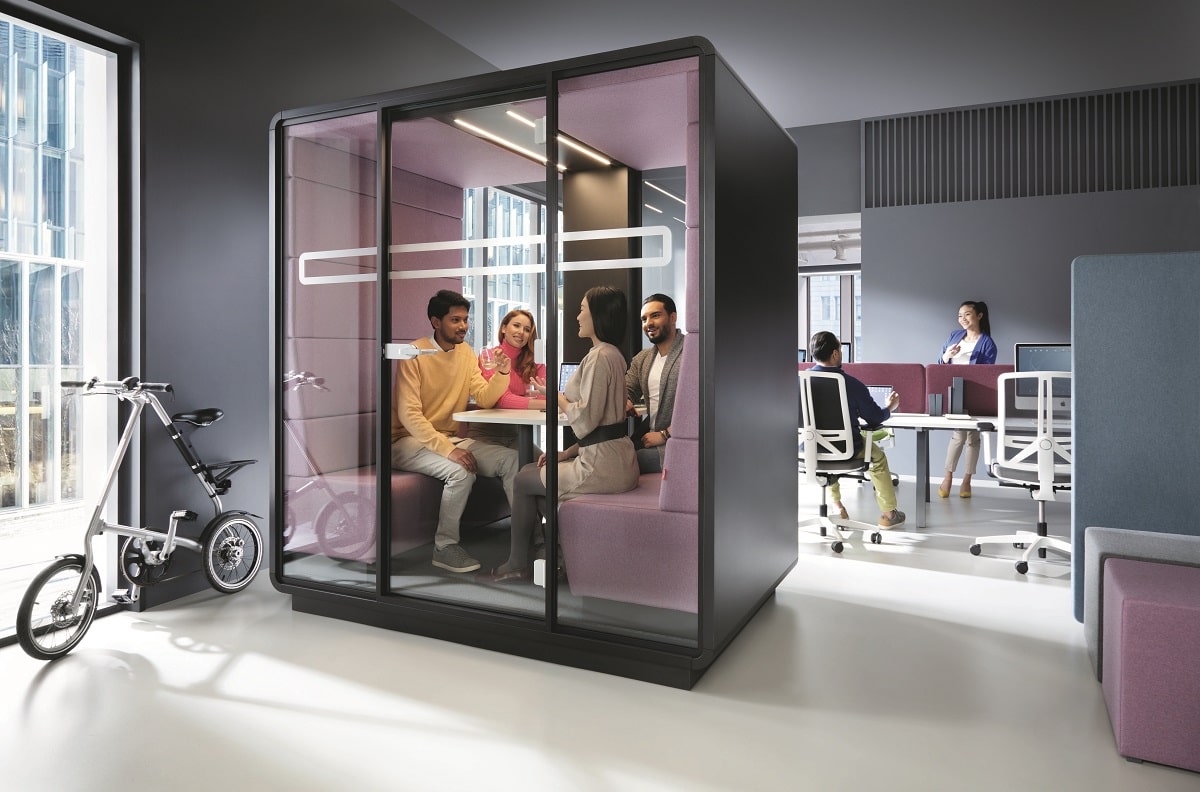
The tangible benefits of having friends at work are numerous.
Friendships at work have an effect on workers’ pride, dedication, engagement and belief in the management of the company, as well as retention. Those who have a best buddy at work are therefore seven times more likely to be completely engaged, which is important as far as resignations occurring both quietly (and loudly) are concerned.
Read: How “isolation” pods make the office more social, not less
Activity-based design will become more and more common, with appropriate attention to acoustic-oriented privacy.
Working remotely made the real purpose of the office more clear. Employee demands are increasingly being determined by work patterns and habits rather than by titles. As a result, ABW layouts will become more popular this year, providing task-oriented areas that are sensitive to group dynamics and appropriate for a hybrid environment.
The advantages of task-oriented approach in terms of office layout are too strong to be dismissed.
On average, Activity Based Working has been shown to improve general workplace happiness by 17%, increase individual productivity by 13% and team productivity by 8%, and foster a stronger sense of community in the workplace by 4% for organisations that use it.
Workplaces that are activity-oriented will encourage the independence that modern workers long for.
As previously indicated, the diversity of workplaces in an effectively designed activity-oriented place of employment facilitates task-environment-fit for people working there. Interestingly enough, one of the five working necessities identified by the U.S. Surgeon General is now perceived autonomy in the job, which is increased by this fit.
Productivity is greatly increased by autonomy
Autonomy is linked to decreased work-family conflicts, more job satisfaction, and fewer plans for turnover
Autonomous workers experience lower levels of anxiety, irritation, and have fewer medical visits
This year, quiet spaces full of privacy will no longer be negotiable.
Nearly 80% of employees claim that having access to specialised workstations affects their productivity. Privacy, which is intricately related to general well-being, truly represents a major component that makes or breaks ABW design. In actuality, the degree of privacy a space offers is the primary factor considered by employees when selecting an appropriate spot according to ABW standards.
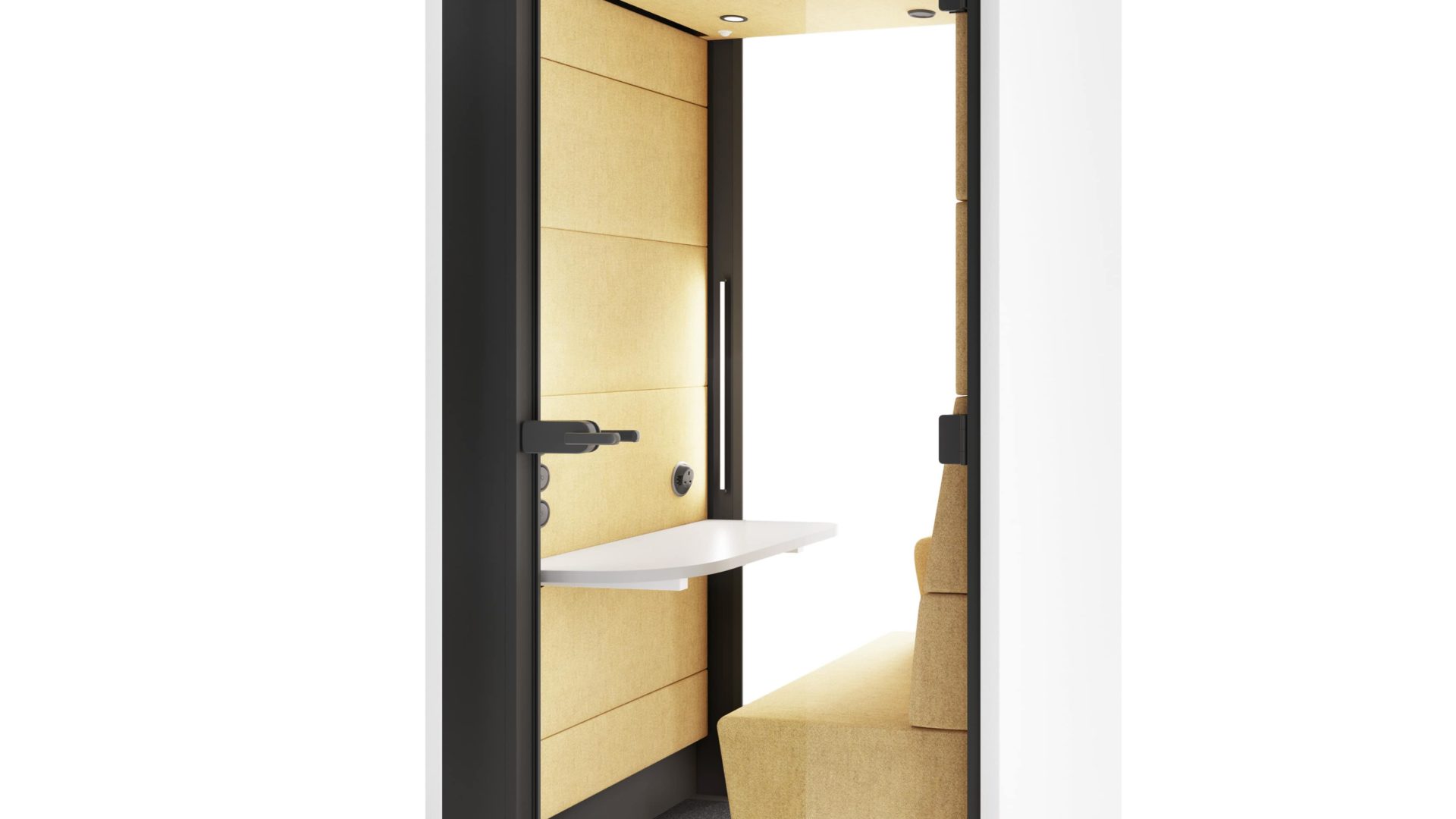
Office privacy pertains to four senses: smell, sound, vision, and personal space.
As employee’s need for privacy is becoming more and more pronounced, office pods will become the norm. The worker is shielded from external attention and visual stimulation sitting in a pod. They are protected from outside sounds and from being heard. On top of that, they are entitled to a private space that is off-limits to others.
It’s freedom in a nutshell.
Mobility freedom. Freedom as far as working in the most productive space for the task is concerned. Freedom of having control over one’s personal space and being assured of privacy when working intently. Freedom of operating freely as a cohesive team, functioning much like an efficient machine. The office will adjust to providing for those kinds of freedoms this year.
Office design trends for 2024 – summarized
As employee’s need for privacy is becoming more and more pronounced, office pods will become the norm.
The office arrangement will be designed using a more multisensory approach by planners. This method will best support neurological diversity by providing a range of sensory scapes.
Wide task-environment-fit will be pivotal in an ever-more diversified workforce. The way forward resides in adaptable interior concepts. Therefore, adjustable furniture and sit-stand desks will become standard.
86% of workers would rather work for organisations that are concerned about the challenges they face. Therefore, it will be crucial that new office products “do good” this year. i.e., steward earth and advance societal goals. Businesses will seize the chance to uphold these ESG commitments by dint of the office.
There will be a greater importance to the conversation spaces. For the enormous 94% of workers who feel it’s critical that their place of employment is somewhere they identify with, they will foster a sense of community.
Activity-oriented designs, which prioritise acoustic seclusion, are expected to gain prominence.
This year, private places will no longer be negotiable. Nearly 80% of workers claim that their productivity is dependent upon them.
FAQ concerning 2024 office design trends
Which of the workplace design trends are most anticipated to be crucial for 2024?
Adaptable interior concepts, including furniture. Activity-oriented design. Private places such as Hushoffice pods. User-adjustable elements like ventilation and light fitting that allow for personal autonomy.
Are workers concerned about ESG?
86% of workers claim they would rather work for organisations that are concerned about the challenges they face.
How does task-environment-fit work?
The alignment of an employee’s work environment with their task needs is known as task-environment-fit. Employees work better and are more satisfied with their setup when there is a good “fit”. The secret to guaranteeing this fit in an activity-based workplace is rather simple: provide a wide range of workspace options.



